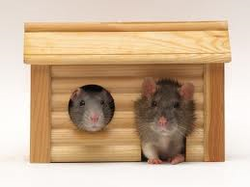
HOUSING
One of your first, and fairly important decisions is what to house
your rat in. It is your largest initial investment in your rats and
not something you want to take lightly. Your housing decision
determines how many rats you can keep (and keep healthy), what
quality of life they have, how often you have to clean it, and what
sorts of enrichment equipment you can use like hammocks, tubes, and
toys.
Rats will never be as cheap a pet as a hamster. If you're looking for cages to be as cheap as hamster cages, you're going to be disappointed. Don't rob your rats of a quality home. “I wish I had gotten a bigger cage for my rats” is something commonly heard, even when people go with the smaller of the acceptable cages. Invest in your rats' health and happiness at the start.
If you'd like the short version, click here. Then, if you don't understand or disagree, return here and keep reading.
Overall space is your first consideration. Rats prefer tall cages over wide cages so they can climb them, and they prefer horizontal bars over vertical bars for the same reason. That alone should rule out guinea pig, rabbit, and other wide cages but there are other reasons to avoid those that will be discussed in a moment. A good rule of thumb is no less than 1.5 cubic feet per female rat or 2 cubic feet per male.
Here is a cage calculator to help determine if the dimensions of a cage you are considering is of an appropriate size.
For the health and well-being of our rats, New Ken Rat Rescue will not adopt out rats to be housed in small cages.
However, cage size is not your sole concern.
The spacing of the bars in a cage you are considering should be 1/2” or less. Older (larger) rats would be fine with larger spacing but the younger ones will walk right through the bars, setting them free on unsuspecting yogies everywhere. This effectively eliminates guinea pig, rabbit and ferret cages...at least while the rats are small. People have cleverly modified these cages with hardware cloth and the like but when you calculate the cost of modification plus your time plus sharp edges I suspect you'll find just getting the right cage in the first place to be the best choice.
Plastic cage bottoms are risky. Some rats leave them alone, others chew a hole in them and walk out to ravage the yogies. It probably won't happen overnight. Your rats probably won't all of a sudden decide to start chewing them. Then again, do you want to risk your yogies?
Aquariums are poor choices for rats. Lack of ventilation means ammonia from their waste gets concentrated into their lungs which often leads to respiratory problems. This would also mean very frequent cleaning is required. Furthermore, their wide not tall configuration does not lend itself to climbing accessories which would be a requirement since the sides cannot be climbed.
From here, take a look at some suggested cages.
Rats will never be as cheap a pet as a hamster. If you're looking for cages to be as cheap as hamster cages, you're going to be disappointed. Don't rob your rats of a quality home. “I wish I had gotten a bigger cage for my rats” is something commonly heard, even when people go with the smaller of the acceptable cages. Invest in your rats' health and happiness at the start.
If you'd like the short version, click here. Then, if you don't understand or disagree, return here and keep reading.
Overall space is your first consideration. Rats prefer tall cages over wide cages so they can climb them, and they prefer horizontal bars over vertical bars for the same reason. That alone should rule out guinea pig, rabbit, and other wide cages but there are other reasons to avoid those that will be discussed in a moment. A good rule of thumb is no less than 1.5 cubic feet per female rat or 2 cubic feet per male.
Here is a cage calculator to help determine if the dimensions of a cage you are considering is of an appropriate size.
For the health and well-being of our rats, New Ken Rat Rescue will not adopt out rats to be housed in small cages.
However, cage size is not your sole concern.
The spacing of the bars in a cage you are considering should be 1/2” or less. Older (larger) rats would be fine with larger spacing but the younger ones will walk right through the bars, setting them free on unsuspecting yogies everywhere. This effectively eliminates guinea pig, rabbit and ferret cages...at least while the rats are small. People have cleverly modified these cages with hardware cloth and the like but when you calculate the cost of modification plus your time plus sharp edges I suspect you'll find just getting the right cage in the first place to be the best choice.
Plastic cage bottoms are risky. Some rats leave them alone, others chew a hole in them and walk out to ravage the yogies. It probably won't happen overnight. Your rats probably won't all of a sudden decide to start chewing them. Then again, do you want to risk your yogies?
Aquariums are poor choices for rats. Lack of ventilation means ammonia from their waste gets concentrated into their lungs which often leads to respiratory problems. This would also mean very frequent cleaning is required. Furthermore, their wide not tall configuration does not lend itself to climbing accessories which would be a requirement since the sides cannot be climbed.
From here, take a look at some suggested cages.